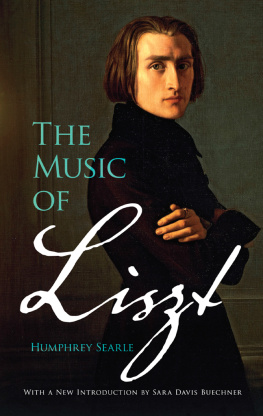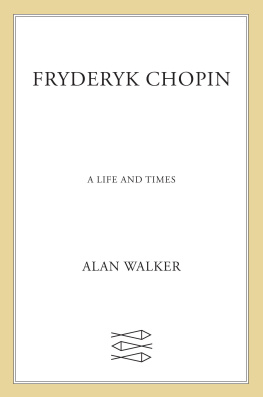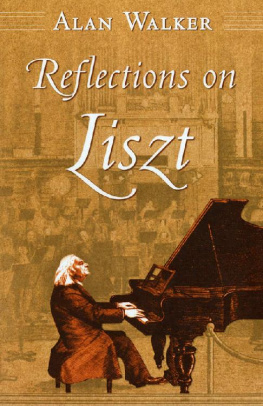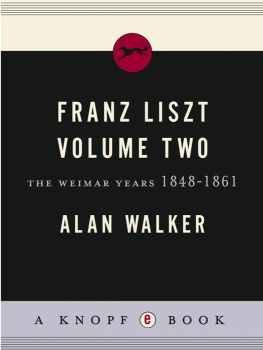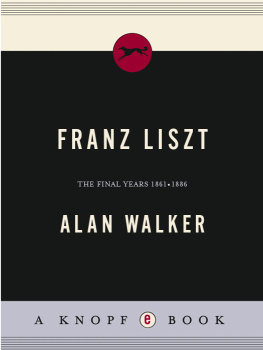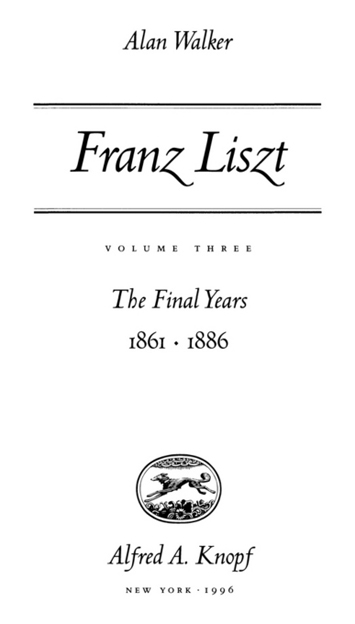Franz Liszt, an oil portrait by Mihly Munkcsy (1886). ()
THIS IS A BORZOI BOOK
PUBLISHED BY ALFRED A. KNOPF, INC.
Copyright 1996 by Alan Walker
All rights reserved under International and Pan-American Copyright Conventions.
Published in the United States by Alfred A. Knopf, Inc., New York.
Distributed by Random House, Inc., New York.
Musical examples drawn by William Renwick.
LIBRARY OF CONGRESS CATALOGING-IN-PUBLICATION DATA
(Revised for vol. 3)
Walker, Alan, [date]
Franz Liszt.
Vol. 23 : 1st ed.
Includes bibliographical references.
Contents: v. 1. The virtuoso years, 18111847
v. 2. The Weimar years, 18481861
v. 3. The final years, 18611886.
1. Liszt, Franz, 18111886. 2. ComposersBiography.
I. Title.
ML410.L7W27 1983 780.92 8247821
eISBN: 978-0-307-83097-5
v3.1
To Lisztians across the world,
wherever they may be, these volumes
are affectionately dedicated.
Contents
Liszt says farewell to Weimar and sets out for Rome ~ he arrives in the Eternal City on October 20, where he is reunited with Princess Carolyne after a separation of eighteen months ~ their wedding is planned for October 22, his fiftieth birthday, but it is abruptly cancelled on the eve of the ceremony by order of the president of the Holy Congregation, Cardinal Caterini ~ aftershocks and recriminations ~ Carolyne blames scheming Russian intrigues ~ the role of Gustav Hohenlohe in the thwarted marriage considered ~ Carolyne takes up permanent residence in Rome, and lives at Via del Babuino 89 ~ Liszt moves to Via Felice 113, uncertain what to do and where to go.
Liszt explores Romes architecture: the Colosseum, the Sistine Chapel, the Forum, and the Baths of Diocletian ~ he laments the lack of public concerts and describes Rome as a musical wilderness ~ he acquires two new pupils: Giovanni Sgambati and Walter Bache ~ he strikes up friendships with important clerics, including Monsignor Francesco Nardi ~ his compositions include the two concert studies Waldesrauschen and Gnomenreigen and the Weinen, Klagen Variations.
Blandine gives birth to Daniel ~ post-natal complications ~ the treatments of Dr. Charles Isnard ~ the death of Blandine, September 11, 1862 ~ Ollivier visits Liszt in Rome ~ Ollivier returns to La Moutte and falls ill ~ after seven years he takes a second wife, Marie-Thrse Gravier.
Liszt withdraws to the Madonna del Rosario ~ a description of the monastery ~ he is visited by Pius IX and a clerical entourage on July 11, 1863 ~ Pius sings Bellini and Liszt accompanies ~ Liszt composes his two Franciscan Legends in the monastery ~ among his callers are Walter Bache, Eduard Remnyi, and the diplomat Kurd von Schlzer ~ Liszt completes his Beethoven symphony transcriptions ~ at the popes request Liszt plays in Rome at a charity concert for Peters Pence ~ the pope invites him to his summer retreat at Castel Gandolfo ~ he attends the Tonknstler-Versammlung festival at Karlsruhe ~ he visits Cosima and Hans von Blow at Starnberg Lake ~ the growing turmoil between Cosima, Hans, and Wagner ~ Cosima confides to Liszt that her marriage to Hans is about to collapse ~ Liszt takes Cosima with him on his travels through Germany to keep her away from Wagner ~ Liszts first return to Weimar since leaving the city ~ he meets Carl Alexander, who vainly tries to persuade him to return to the city ~ Liszt and Cosima travel to Paris and thence to Saint-Tropez, where they visit Blandines grave ~ Liszt celebrates his fifty-third birthday at the Madonna del Rosario.
Liszt receives the tonsure on April 25 ~ he is admitted to holy orders on July 30 ~ the reactions of his contemporaries ~ he moves into Hohenlohes private quarters in the Vatican ~ he plays for Pius IX on the twentieth anniversary of the pontiffs coronation ~ accompanied by Cosima and Hans von Blow, he visits Hungary and conducts his St. Elisabeth, wearing a cassock for the first time in public ~ the trio travels to Gran, where Liszt plays for Cardinal Scitovszky ~ from there they go to Szekszrd where Liszt stays as a guest of Baron Augusz ~ after a short trip to Venice Liszt returns to the Vatican ~ resumes work on his oratorio Christus.
Death of Liszts mother ~ Emile Ollivier delivers the funeral oration ~ Sgambati conducts the first performance of the Dante Symphony in Rome ~ Liszt travels to Paris, where he settles his mothers estate ~ he meets many French musicians, including Saint-Sans and Auber, and is taken up by Princess Pauline Metternich ~ the failure of the Gran Mass at its Paris premire at the church of Saint-Eustache ~ Walter Baches description of the dbcle ~ the hostility of the press ~ Liszt attempts to justify his setting of the mass to dOrtigue, Berlioz, Damcke, and Kreutzer ~ he hears Csar Franck play the organ ~ Napoleon III invites Liszt to the Tuileries ~ from Paris to Amsterdam, where he is reunited with Cosima and Hans von Blow ~ a Liszt Festival is mounted in his honour by the Dutch conductor Herman van Bree ~ Blow gives the world premire of the Spanish Rhapsody ~ back in Paris Liszt is received at the Tuileries by Empress Eugnie ~ he meets Marie dAgoult on three occasions ~ she chooses this moment to re-publish her old novel Nlida ~ Madame dAgoult gives me no quarter, he writes ~ Liszt returns to Rome.
The Blows with Wagner in Munich ~ Cosima recalls giving birth to her daughter Blandine in Berlin unaided ~ Wagners sumptuous life-style in Munich ~ the affair between Cosima and Wagner develops ~ the difficult question of Blows complicity ~ Wagners relationship with King Ludwig II ~ his plans for a music school and a new opera house ~ Blow makes enemies ~ the world premire of Tristan and its attendant woes ~ Cosima gives birth to Wagners daughter Isolde ~ the death of Ludwig Schnorr ~ Wagner requests more money from the Bavarian treasury ~ bags of coin in a taxicab ~ Wagner is banished from Munich ~ he moves to Switzerland ~ the death of Wagners wife, Minna ~ he leases Triebschen, by Lake Lucerne ~ the Blows join him there ~ of scandal and outrage ~ the strange case of Malvina Schnorr ~ Cosima gives birth to another Wagner daughter, Eva ~ Liszt visits the Blows at Munich in a desperate bid to save their marriage ~ he confronts Wagner at Triebschen ~ his arrangement of the Liebestod from Tristan.
Blow gives the world premire of Meistersinger at Munich ~ his conflicts with Wagner ~ Cosimas continued infidelity ~ she deserts Blow and lives openly with Wagner in Switzerland ~ their life at Triebschen ~ Liszt condemns Cosima ~ Blow seeks a Protestant divorce ~ Blows letter to Claire de Charnac ~ Cosima marries Wagner in Lucerne ~ Blow resigns from Munich and embarks on a long concert tour of America ~ he suffers a nervous breakdown and becomes suicidal ~ Blows subsequent conduct towards Cosima and their daughters ~ he remarries.








